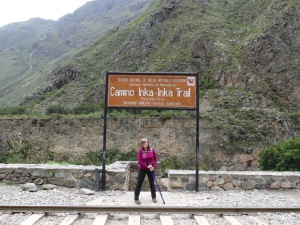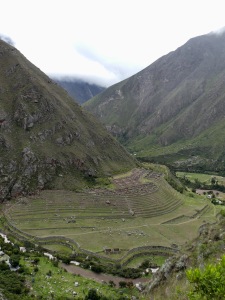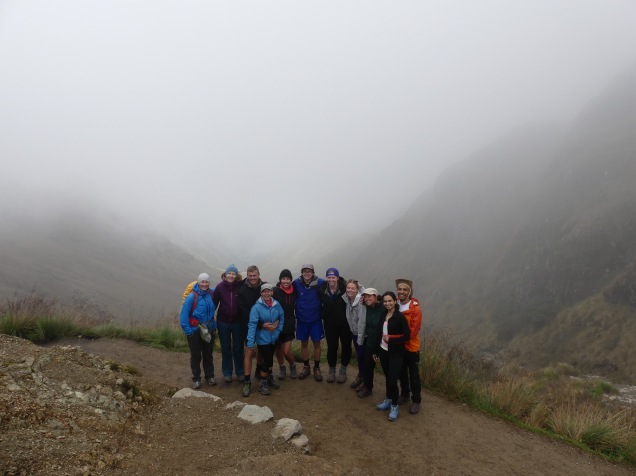In the footsteps of the Incas – part 1
It has been a lifetime dream to walk in the footsteps of the Incas along steep valley sides and over the rocky mountain passes and reach Machu Picchu from the Sun Gate. It’s impossible to capture the ongoing breathless wonder of the four day adventure with the awesome guides, porters & fellow hikers in my Peru Treks Inka Trail family, or that feeling of your first glimpse of this incredible citadel in the clouds, but here goes…
Day 1: Piscacucho to Wayllabamba, 12km


It’s still early morning at Piscacucho, also known as Km82, as our group of 11 trekkers gather to start a 4 day trek to Machu Picchu. We grin for the classic starting post photocall, but behind the smiles many of us later admit we were feeling nervous. I know I am. Will I survive the altitude, climbing up to 4,200m? Am I even fit enough to make it over the notorious Dead Woman’s Pass? Without crying? Have I got enough blister plasters?
There’s no time to dwell. Sixteen porters, in their yellow and black track suits, have already shouldered enormous packs of tents, pots and pans, gas bottles, food, sleeping mats and more, our passports are checked, we’re off across the suspension bridge spanning the Vilcanota River, and on our way. Our guide Manuel calls us his family, and tells us to call him Manny. We call him Dad. Marco, the co-guide, is Mum.

The track climbs steeply for a short way, testing our lungs for what is to come, but then is more gently undulating as we get our first glimpse of a ruined Inca fort above us, and scramble up the rocky path for our first stop, and brief introduction to the Inca civilisation which, despite its historically short period of domination from founder Manco Capac to the final defeat of Atahuallpa and Manco Inca Yupanqui in the mid 1500s, managed to build so many fortresses, temples and palaces, revolutionised agricultural practices and stretched so far across the Andean region.
But this fort is modest compared to what we see a little further downhill, when we walk to the edge of the precipice and gaze down on Llactapata, first ‘discovered’ by US explorer Hiram Bingham, a whole town of houses, barracks, storerooms and terraces on which crops like maize and potatoes were grown.

Come lunchtime, the very efficient porters have already set up tents and even placed bowls for us to wash our hands. Tables and chairs are laid out, even a dark red table cloth. The food that follows, given it’s come from a camp kitchen astonishes and delights us – three courses of stuffed avocado, corn soup and fried trout with vegetables with cheese and rice! It’s all quite delicious!
As we carry on along the valley side, we regularly have to hug the mountain side as the porters keep trotting past us, many of them wearing just sandals or light gym shoes, yet still as sure footed as llamas with their heavy burdens.
The path rises and falls in the steep valley, rufous-collared sparrows are everywhere, and I spy a tiny green iridescent hummingbird amongst the plants, whilst high in the trees and amongst the rocks across the valley small groups of some sort of parakeet flit and squawk at each other. By late afternoon we’ve reached the mountain village of Wayllabamba, our campsite stop for the night, a row of green dome tents already set up on a grassy terrace next to a small set of farm buildings and houses. As the clouds lift, Apu Veronica with its snow capped glacier rises in the distance several valleys away – it’s a glorious view as the sun slowly slips behind the mountains. We wander up to the Inca ruins just above our campsite. Next to it, on a dirt football pitch, a team of porters and guides is taking on a team of local villagers – with more energy than I could have thought possible! Dinner by lamplight is a cosy affair, with more delicious soup followed by tortillas with vegetables and rice, as we huddle together in our alpaca hats in the tent – it’s pretty cold now that night has fallen. By 8pm we’re all snuggled up in our tents for the night.

Day 2: Wayllabamba to Pacamayo, 12km
We’re woken at 5.30am by Marco and the porters with hot tea in bed! Mindful of the big climb ahead I choose maté de coca. It’s still cold, and today is the day we go over the highest pass. Chef Benedicto has magicked up quinoa porridge (we put chocolate in it), and pancakes with caramel sauce and banana for breakfast!

The porters all gather for a proper introduction and there are football squad style photos – my fellow trekker from Canada, Shawna throws herself down on the grass cheerleader style to give them all a giggle! We’re back on the trail and climbing steadily but not too steeply at first by 7am, following a river and over a bridge, spying orchids growing in the tangle of plants, shrubs and bushes around us. We pass the last inhabited house on the trail – the family still live there but as children grow up and continue their education in the towns and decide to stay there, we’re told it’s unlikely to remain a family home for more generations and, as it is now in the heart of a heritage site, it can’t now be sold to another family.

At our first rest stop, our porters come past again, and as they do, Manny and Marco introduce them individually by name and we give them a cheer – Benedicto especially gets a big clap. The next stretch is going to be steep, rocky steps, with several hundred metres climb – Manny proffers his supply of coca leaves and tells us how to chew them, to help with the altitude.

They’re pretty bitter, but I also have coca sweets flavoured with Muña, a type of Andean mint, and the combination isn’t too bad. Whether it’s chemical or purely psychological, chewing and sucking the leaves and sweets definitely helps calm my thumping heart, and heaving lungs as step-by-step we haul ourselves upwards. At the next stop there is tea and cheese rolls, before the final hurdle up to the ominously titled Abra de Huarmihuañasca, or Dead Woman’s Pass, the highest point at 4,200m.
The clouds have come down the valley, it feels almost ethereal zig-zagging back and forth on the rocky stepped path. I’ve never used trekking poles before this walk, but I’m increasingly glad of them now, especially on the narrower and steeper parts to give that extra lift. My pace has slowed dramatically, and my thighs and knees are burning, when from above I hear a cheer – Marina, Will, Jono & Emma in our group have made it to the top – as I get closer they yell “C’mon Family! Familia!”, fuelling extra final burst of happy energy for the last few stone steps. We’ve made it! We’ve literally walked up into the clouds, which now swirl around us, occasionally parting to give a Brigadoon-like glimpse of the last camp far down below in the valley, appearing and disappearing in the mist. We can see the whole of the trail, with a multicoloured string of tiny trekking ants. I struggle to suppress a smug feeling that I’ve made it and they’re still climbing!


Anxious to escape the cold, damp air, we plough on over the top and down the extremely steep and often narrow steps on the other side, often having to take them one at a time, sideways. How on earth this path first got carved is mind-boggling – it’s a true feat of mountainside engineering. It gradually eases off as we drop into the valley beyond, and a lovely waterfall appears to our left, tumbling over sheer rocks, disappearing, then reappearing. It’s the same river that flows past our campsite at Pacamayo, six hundred metres below the pass, where we arrive for a very late lunch at about 3pm. The heavens open and it rains heavily as we sit down, and quickly gathers into deep pools on the tent roof. Benedicto has once again worked wonders in his camp kitchen, without an oven somehow m aking pizza slices as an appetiser – they’re so delicious I could have eaten the whole pizza! More soup with quinoa, and the Peruvian classic stir fry beef dish lomo saltado (with mushroom saltado for us veggies). If this guy ever opens a restaurant, I’ll be first in the queue!

The rest of the day is spent resting – the rain is beating steadily on the tent, so I snuggle into my sleeping bag, listening to music and podcasts and dozing until dinner and another Benedicto feast! There is so much food on this trek I’ve hardly touched the snacks I brought along with me!
At the end of day two I feel a mixed bag of emotions – from elation at having got over the pass, to a slight loneliness that, although I’m with a bunch of awesome people, I’m doing this trek alone. I think how much my sisters Julie and Sarah would have loved the whole adventure, and how much fun we’d have had together, or the hummingbirds that I know my friend Liz would have shared the thrill at seeing.
But most of all, it’s a sense of excitement and anticipation I feel as I drift into sleep despite the very hard gravelly surface we’re camped on tonight.
Because Machu Picchu is now just one day’s trekking away….
I was so excited to read this! Am going to dig out my travel diary and compare notes. I do remember that, when I got back to London afterwards, I went for a run and for once and the only time in my life, felt I could have gone on for hours (though I didn’t). That’s altitude training for you! I was on my own in a group too, so I know how it feels. Glad you had a great group and guides. It’s a fantastic experience.
LikeLiked by 1 person
Oh Dot I thought about you a lot too – and how much fun to have done it together, if you hadn’t got there before me! 🙂
LikeLike
don’t keep us in suspense for too long! looking forward to reading more about your trek.
LikeLike
You’re dead right Sis! I certainly would have loved to be with you but at least with your blog I can walk the trail without hurting to getting breathless! I’m not sure I would have made it for real but who knows, maybe one day?
LikeLiked by 1 person
I did wonder about your dodgy knee would have coped, there are SO MANY steps! But the sticks really do help take the strain – who knew?! 😀
LikeLike